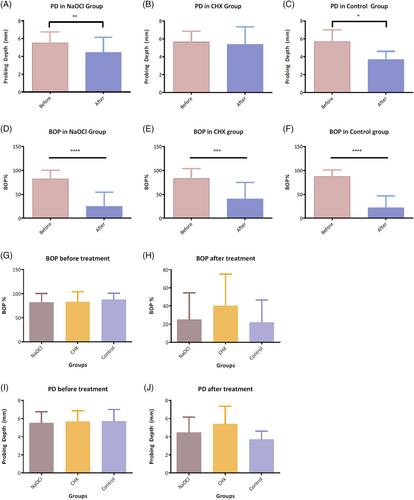Impact of surface chemical treatment in surgical regenerative treatment of ligature-induced peri-implantitis: A canine study
Abstract
Background
Implant surface decontamination is a critical step in peri-implantitis treatment. The aim of this study was to assess the effect chemotherapeutic agents have on reosseointegration after treatment on ligature-inducted peri-implantitis.
Methods
Six male canines had 36 implants placed and ligatures were placed around them for 28 weeks to establish peri-implantitis. The peri-implant defects were randomly treated by 1 of 3 methods: 0.12% chlorhexidine (CHX test group), 1.5% sodium hypochlorite (NaOCl test group), or saline (Control group). Sites treated with NaOCl and CHX were grafted with autogenous bone, and all sites then either received a collagen membrane or not. Histology sections were obtained at 6 months postsurgery to assess percentage of reosseointegration.
Results
Thirty-five implants were analyzed (CHX: 13; NaOCl: 14; Control:8). NaOCl-treated sites demonstrated reosseointegration with direct bone-to-implant-contact on the previously contaminated surfaces (42% mean reosseointegration), which was significantly higher than Controls (p < 0.05). Correspondingly, clinical improvement was noted with a significant reduction in probing depth from 5.50 ± 1.24 mm at baseline to 4.46 ± 1.70 mm at 6-months postsurgery (p = 0.006). CHX-treated sites demonstrated a nonsignificant reosseointegration of 26% (p > 0.05); however, in the majority of cases, the new bone growth was at a distance from the implant surface without contact. Probing depths did not improve in the CHX group. The use of membrane did not influence reosseointegration or probing depths (all p > 0.05).
Conclusion
Titanium implants with peri-implantitis have the capacity to reosseointegrate following regenerative surgery. However, treatment response is contingent upon the chemotherapeutic agent selection. Additional chemical treatment with 1.5% NaOCl lead to the most favorable results in terms of changes in defect depth and percentage of reosseointegration as compared to CHX, which may hinder reosseointegration.


 求助内容:
求助内容: 应助结果提醒方式:
应助结果提醒方式:


